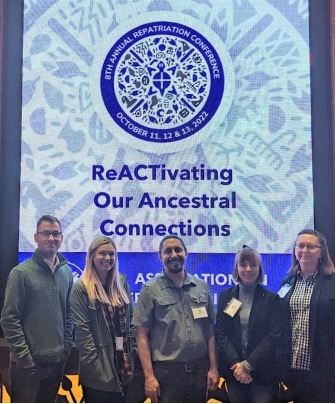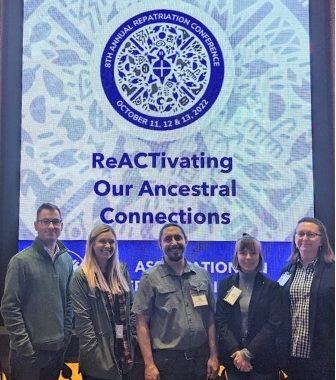
CMC Blog
Introduction to NAGPRA
By: Tyler Swinney, Manager, NAGPRA, Archaeology Collections, Tribal Liaison

Tyler Swinney and other Cincinnati area NAGPRA Professionals at the 8th Annual Repatriation Conference, October 13th, 2022.
What is NAGPRA?
NAGPRA is an acronym that stands for the Native American Graves Protection and Repatriation Act. It is federal legislation that was passed in 1990 to provide a process for federally recognized Tribal Nations, lineal descendants, Alaska Native Corporations, and Native Hawaiian organizations to claim certain cultural items and ancestral remains from organizations that received federal funds after 1990. At its core, NAGPRA is human rights legislation that was enacted by congress to addresses inequalities between federally recognized descendant communities, the US government, and institutions that control ancestral remains and cultural items affiliated with sovereign Tribal Nations indigenous to the United States. NAGPRA also establishes procedures for inadvertent discoveries on federal and tribal lands and makes it illegal to traffic ancestral remains and cultural items obtained through activities that violate the Act.
Who Must Comply with NAGPRA?
NAGPRA defines who must participate in a variety of compliance activities that emphasize transparent information-sharing, consultation, and reporting of NAGPRA holdings. Simply put, any organization that has accepted federal funds after 1990 and is in possession of NAGPRA objects or Native human remains must comply with NAGPRA. Similarly, any institution that wishes to apply for federal funding in the future must be in compliance with NAGPRA. Noncompliance means that an organization is ineligible to receive federal funds and is subject to civil penalties and sanctions.
What Items are Subject to NAGPRA?
NAGPRA applies to human remains and cultural items that meet specific criteria. These include items that served a funerary function, or have ongoing sacred, ceremonial, historical, traditional, or cultural importance. The statute defines items that fall under the purview of NAGPRA in section 2, including “funerary objects”, “sacred objects”, and “objects of cultural patrimony”.
- Funerary Objects include any item that was placed with or near human remains as part of funerary activities, and are subdivided into “associated” and “unassociated” categories.
- Scared Objects include ceremonial items that are used by Native religious leaders during the practice of traditional religions, past and present. These can include items required to renew ceremonies that may have been dormant due to restrictions imposed by the US government.
- Objects of Cultural Patrimony are items that were owned communally by a Tribal Nation or subgroup, and could not be exchanged, sold, or given away by any one individual. Patrimonial items have ongoing cultural importance or historical significance to a Native group or culture.
What is the NAGPRA Process/What does NAGPRA require museums to do?
The NAGPRA process is done collaboratively with appropriate federally recognized descendant communities interested in filing a repatriation claim. It is important to emphasize that the goal of NAGPRA is the return of NAGPRA objects and ancestral remains to their rightful communities.
Throughout the NAGPRA process, museums and descendant communities have specific responsibilities. For museums, initial responsibilities relate to identifying and summarizing NAGPRA holdings within their control and notifying all federally recognized descendant communities that are affiliated or potentially affiliated. After formal notification, museums must begin to compile detailed inventories of all NAGPRA items and ancestral remains included in each collection. During the inventory process, museums must also consult with appropriate descendant communities and make salient information about each collection available upon request. For descendant communities, the principle responsibilities revolve around (1) determining if collections are covered under NAGPRA; (2) identifying if museums or federal agencies have clear title and right of possession of NAGPRA items (excluding human remains), and (3) researching evidence needed to sustain a repatriation claim.
Following the inventory and consultation process, museums are required to publish specific notices in the Federal Register announcing their findings and to give public notice prior to repatriating or transferring ancestral remains or cultural items to descendant communities. The most important notice is referred to as a Notice of Inventory Completion (NIC) which is a determining document that is published when a museum determines ancestral remains are culturally affiliated to a descendant community (initiating the repatriation process) or offers to transfer ancestral remains that could not be culturally affiliated to a modern descendant community (initiating the disposition process). The public notice period is 30 days and if no objections arise, then the process of transferring control and ownership of the NAGPRA items addressed in the NIC can begin in preparation for repatriation or disposition.
NAGPRA Resources:
National NAGPRA Program – https://www.nps.gov/nagpra/INDEX.htm
Association on American Indian Affairs – https://www.indian-affairs.org/nagpra-compliance.html
Mihesuah, D. A. (2000). Repatriation Reader: Who Owns American Indian Remains. University of Nebraska Press.
Echo-Hawk, R.C. (2002). Keepers of Culture: Repatriating Cultural Items Under NAGPRA. Denver Art Museum.
Special Issue: NAGPRA and The Next Generation of Collaboration. The SAA Archaeological Record, Volume 15, No. 1, January 2015. Available Online at: http://onlinedigeditions.com/publication/?m=16146&i=243297&p=6&ver=html5
Museum Admission
Includes Cincinnati History Museum, Museum of Natural History & Science and The Children's Museum
| Adult: | $22.50 |
| Senior: | $15.50 |
| Child: | $15.50 |
| Member Adult: |
FREE |
| Member Child: |
FREE |
Members receive discounts!
Become a Member today to save on programs, exhibits and films throughout CMC.
Museum Hours
Open Thursday – Monday
10 a.m. to 5 p.m.
Closed Tuesday and Wednesday
Closed Thanksgiving Day and Christmas Day
Member’s-only early entry: Saturdays at 9 a.m.
Customer Service Hours:
Monday – Sunday, 9 a.m. to 5 p.m.


